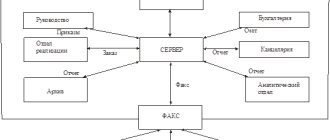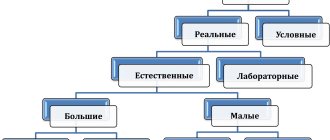Introduction
Body language is a language that almost everyone understands. Usually this happens completely unconsciously, without thinking. Body language is a signal that is transmitted from one person to another, which is why scientists also call this communication “non-verbal communication.” During intimate contact, a glance and touch are more expressive and provide more complete information than many words.
The language of body movements was very important already in Ancient Greece. For example, great importance was attached to posture. A man must hold his head high, otherwise he may be mistaken for a homosexual. Women and children, on the other hand, should not look the other person directly in the eyes. The casual look showed shyness, modesty and submissiveness.
In the XVII-XVIII centuries. In Western countries, books of the century were published on the rules of good sound. For example, in 1735, S. Van Par's book “The Great Ceremonial Book of Good Manners” was published, containing 500 pages.
The first book entirely devoted to gestures was the work of D. Balver “Chirology: either the natural language of the hand and chironomy, or the art of rhetoric of the hands.” And Francis Bacon even proposed creating a science of gestures. In the late 19th century, gestures were studied by anthropologists and psychologists.
In 1939, a three-volume monograph by I.A. appeared in Russia. Sobolevsky, in which the author presented his view on nonverbal communication.
Research into the meaning of human body language continues, as evidenced by international conferences and scientific reports, for example, the collection “Gestures and Moods from Antiquity to the Present,” published in England.
Communication with a patient after a stroke
People who have suffered a stroke often develop speech impairments. Examples of such a disorder are difficulty pronouncing sounds and misunderstanding of speech. In medicine, such dysfunction is called aphasia and dysarthria.
Speech disorders after a stroke isolate people from others, make a person feel lonely, and lead to depression, which extends the adaptation period for years. For this reason, in the process of rehabilitation in the family, proper communication with the patient is important:
- When speaking, it is preferable to use short phrases.
- It is not recommended to talk loudly to the patient, as such speech complicates understanding.
- When a patient uses a new term for something or someone after a stroke, it is worth using this word or sound in the future for communication.
- You should not insist that patients use the correct, generally accepted names and terms - this will cause a negative reaction.
- It is imperative to respond to the patient’s speech, without forcing him to speak in a common language; if it presents difficulties, a person’s reaction after a stroke may be to stop communicating.
Some patients with aphasia tend to understand nonverbal communication, body language, and gaze. They may not understand speech, but can guess the wishes of the interlocutor by “reading” information from gestures and facial expressions. It is necessary to accurately determine the patient's level of speech understanding. To do this, you need to say one thing, demonstrating with gestures and facial expressions the opposite of what was said. This will eliminate exaggeration of the patient's ability to speak and understand.
Nonverbal Communication
Research has shown that only one tenth of the information a person provides is verbal information. The rest comes from gestures, facial expressions, pantomime, eye contact, touch and intonation. The first intuitive “scanning” of a person takes about 20 seconds. People don't always say what they mean, but the body can't lie. Hidden feelings find their way through gestures. The psychology of nonverbal communication is very broad and complex. Once you learn to understand human gestures and their meaning, it will be much easier for you to know the truth.
When a person’s emotional background increases, he stops paying attention to his body. But when trying to untangle someone else's thoughts, situational factors must be taken into account in order for the judgment to be correct. For example, if a person crosses his arms over his chest in severe frost, this can only mean that he is cold, that he is not closed and not closed.
Let's consider nonverbal means of communication.
Developmental exercises in the form of a group game
- "Present". During the game, each player gives a gift to the participant standing to his left. This must be done in such a way that the recipient understands what is being given to him, but it can only be explained using non-verbal means (facial expressions, gaze, body language). The goal of the game is to develop nonverbal communication skills.
- "Everyone's attention." All participants are given the task to attract the attention of others. The difficulty is that this is done simultaneously. The goal of the game is to teach how to combine the nonverbal and verbal components of interaction, and place the right emphasis using different means of communication. Who managed to complete the task? By what means? What means is considered the most important in the process of organizing communication?
- "Figures". During the game, the use of non-verbal means, such as body movements, facial expressions, and gaze, is unacceptable; only speech can be used. The player is given a sheet of paper with geometric shapes depicted on it. He explains to the others (without showing the drawing) what is drawn on the sheet so that they draw the same thing. Then the explainer tells whether it was difficult to describe the image only in words without the help of gestures.
- "Painting". All participants stand in one line. During the game, only facial expressions and gestures are used. There is a sheet of paper attached to the wall. The presenter whispers to the first player the object that needs to be drawn. The first one draws part of the object. Then the first player explains to the second using non-verbal means what object needs to be depicted. The second one draws what he understood. Then the second explains the task to the third and so on until everyone has taken part. Was it difficult to communicate using nonverbal means without speech?
- "Book". Let's summarize. The participants stand in a circle, the book is passed from hand to hand, and the participants take turns briefly telling what conclusions each of them made from the lesson, how he was personally affected by the topic under discussion.
Gestures
Gestures are a lot of hand and head movements. Sign language is the oldest way to mutual understanding. In different historical eras and among different peoples they had their own common way of gesturing.
The intensity of gestures can increase as a person's emotional arousal increases, and also when you want to achieve better mutual understanding between partners, especially when this is difficult.
The specific meaning of individual gestures varies among cultures.
However, all cultures have the same gestures, which we can differentiate between:
- communicative (gestures of greeting, farewell, attracting attention, prohibitions, affirmation, denial, interrogation, etc.).
- modality, i.e. expression of assessment and attitude (gestures of agreement, satisfaction, trust and mistrust, etc.).
- descriptive gestures that make sense only in the context of speech.
Gestures can be open and closed. Overt gestures include movements in which a person places their arms to the side or shows their palms. They indicate that a person is open and ready to communicate. Closed gestures include those that help a person create a psychological barrier. The body can be covered not only by hands, but also by foreign bodies. Such manipulations indicate that the person does not trust the interlocutor and is not ready to open up to him. These can be “closed” fingers or crossed arms.
Literature:
1. Abramov N. The art of talking // Russian speech. - 1991. - No. 4.
2. Vvedenskaya L.A., Pavlova L.G., Culture and the art of speech. Modern rhetoric. Rostov-on-Don. Publishing house "Phoenix". 1996.
3. Goldin V. E., Sirotinina O. B. Speech culture // Russian language. Encyclopedia. - M., 1998.
4. Daletsky Ch. Workshop on rhetoric. - M., 1996.
5. Pease A. Body language. How to read others' thoughts by their gestures. — Nizhny Novgorod, 1992.
Pantomime
Facial expression is the movement of facial muscles, the main indicator of emotions. Studies have shown that when the interviewer's face is silent or invisible, up to 10-15% of information is lost. There are more than 20,000 descriptions of facial expressions in the literature. The main characteristic of facial expressions is their integrity and dynamism. This means that in the facial expressions of the six main emotional states (anger, joy, fear, sadness, surprise, disgust - see Appendix No. 1), all movements of the facial muscles are coordinated. The main information load in facial expressions is carried by eyebrows and lips.
Pantomime
Pantomime is gait, posture, general motor skills of the whole body.
Gait is the way a person moves. Its components: Rhythm, step dynamics, amplitude of body transmission during movement, body weight. By gait you can judge a person’s well-being, character, age, and recognize emotions such as anger, suffering, pride, and happiness. It turned out that a “stiff” gait is typical for people who are angry, while a “light” gait is typical for happy ones.
Position is the position of the body. The human body is capable of taking about 1000 stable different positions. Posture shows how a person perceives his status in relation to the status of others present. People with higher status adopt a more relaxed posture. Otherwise, conflict situations may arise.
The most important semantic content of the pose is to position the body in relation to the interlocutor. This position indicates either a closed position (face with arms and legs crossed) or a communication position.
A closed position is perceived as a position of distrust, disagreement, opposition and criticism. Moreover, the interlocutor did not assimilate about a third of the information received from this pose. The easiest way to come out of this position is to offer something to hold or observe.
The open position is a position in which the arms and legs are uncrossed, the body is directed towards the communication partner, and the palms and feet are turned towards the communication partner. This is a pose of trust, harmony, goodwill and psychological comfort.
If a person is interested in communication, he will focus on the interlocutor and lean back, and if he is not very interested, then, on the contrary, he will focus on the interlocutor and lean back. A person who wants to make a statement will be upright, tense, with shoulders turned; a person who does not need to emphasize his status and position will be relaxed, calm, in a free, relaxed position.
The best way to communicate with your interlocutor is to copy his posture and gestures.
Exercises with a patient after a stroke
An important stage of rehabilitation after a stroke is the restoration of speech. This process is long and requires the patience of the family and the patient himself. You should start classes in a timely manner, since if you miss the favorable moment, the disturbances will become persistent, and speech will not be fully restored.
The correct choice of speech rehabilitation strategy requires an accurate determination of the form of dysfunction after a stroke. In practice, most of the disorders are aphasia:
- Total – observed in the first days after a stroke. The patient does not remember anything or anyone, does not speak and does not understand what they say to him.
- Motor – follows total. The patient recognizes his relatives and understands speech, but he still cannot speak. Later, the patient begins to express desires using sounds.
- Sensory – speech understanding is impaired. These are symptoms indicating damage to the part of the brain that analyzes spoken language.
- Amnestic is characterized by difficulty in naming objects for the patient. This is due to complications when choosing a word from the vocabulary. Memory capacity decreases, retention of information perceived by ear deteriorates.
- Semantic. The patient understands simple phrases and addresses, but does not perceive complex phrases.
Eye contact
Eye contact is also an extremely important element of communication. Looking at the speaker, we can not only feel interested, but also focus on what we are being told. People interacting usually do not look each other in the eyes for more than 10 seconds. If we are not given enough attention, we have reason to believe that we or what we say is being treated poorly, and if we are paying too much attention, it may be perceived as a challenge or good treatment. Additionally, it has been observed that when a person is lying or trying to hide information, their eyes meet their partner's eyes less than 1/3 of the time they speak.
Appearance can be: business, social, intimate, with crossed eyes.
Components of interaction between representatives of the opposite sex
- A flirtatious gait and preening in front of a man, demonstrated by a woman, indicate a readiness to flirt, as do dilated pupils and a long gaze (more than 10 seconds).
- A man shaking off non-existent specks of dust or thumbs in the slits of the pockets (behind the belt) of trousers will tell about his readiness to care for the woman who is interested in him.
- An intimate gaze is when the interlocutor glides from the eyes along the partner’s body and back.
Such signs are given by people unconsciously and indicate mutual attraction.
Touch and Setting Characteristics
The role of contact in nonverbal communication. Here handshakes, kisses, caresses, strokes, blows, blows, etc. stand out. The use of contact in communication is determined by many factors: the status of the partners, their age, gender, degree of acquaintance.
Inappropriate use of a person's sense of touch can lead to communication conflicts. For example, patting on the back is possible only if the relationship is close and the social situation in society is the same.
During communication, it is also important to pay attention to voice characteristics associated with nonverbal communication: tone, volume of the voice, its timbre, its involvement in pauses in speech and various non-morphological human phenomena: crying, coughing, laughter, sighs, etc.
It is necessary not only to be able to listen, but also to hear the intonation system of speech, to appreciate the strength and tone of the voice, the speed of speech, which practically allows you to express your feelings and thoughts.
Voting contains a lot of information about the owner. An experienced voice expert can determine the age, place of residence, health, character and temperament of its owner.
Since the characteristics of the voice depend on the functioning of various organs of the body, it also reflects their condition. Emotions change the rhythm of breathing. Fear, for example, paralyzes the larynx, the vocal cords become tense, and the voice “sits down.” When the mind is well disposed, the voice becomes deeper and richer in shades. It has a calming effect on others and instills more confidence.









